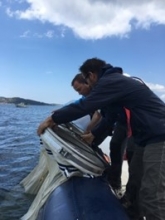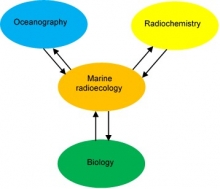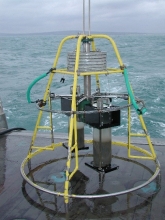Working Group Leads: Céline Duffa (IRSN, France) and Jordi Vives i Batlle (SCK CEN, Belgium)
Contact: celine.duffa@irsn.fr
Working Group Overview
The Fukushima accident has totally modified the vision for marine radioecology by bringing up post-accidental marine studies at the top level of importance. Radioecological models and operational tools dedicated to marine environments in crisis and post accidental situations appear essential to develop/improve and validate our response capacity for this and future nuclear accidents.
Objective
Improvement of knowledge and representation of radionuclide transfer processes in the marine environment in non-equilibrium situations (accidents and planned non-continuous discharges) by:
- Validating and improving models and databases for decision support systems,
- Generating new field data and extrapolation methods to address data gaps,
- Improving existing mechanistic models (dispersion and transfer to biota and sediments)
- Developing research on more realistic (and sophisticated) models taking into account trophic transfer process related to pelagic or benthic organisms.
We address Challenge 1 and Challenge 3 of the SRA: identify and mathematically represent key processes that make significant contributions to the environmental transfers of radionuclides and resultant exposures of humans and wildlife - improve human and environmental protection by integrating radioecology.
Working Group Activities
In post-accidental situations, the need to use dynamic modelling has been demonstrated, with proven results. Dynamic radioecological models that use an empirical approach (biological half-lives) calculate transfers to biota are very useful for emergency and first consequences estimations, but they do not represent the large variability existing due to many species and ecological functioning. More sophisticated "second generation" models applying an ecosystem approach (foodweb modelling) and mechanistic approaches to transfer (resource limitation, metabolism) to predict long term transfer evolution are developed in our marine group. Many data (and probably knowledge) gaps are explored, especially concerning benthic organisms and their interplay with sediment compartments.
The second and also very important item to study is radionuclide transfer to and from sediments, dictating the long-term fate of radionuclides in coastal environments. Both radioecological and hydro-sedimentary modelling (site specific) have to be improved, developed and validated. The transfer from land to sea is also a big issue, including the role of underwater discharges. Here, integrated modelling of sediment/biota/seawater using mass balance approaches offers a way to estimate the source term, residence and clearance times of radionuclides in sediment.
Studies of the speciation of radionuclides in the oceans and the interplay between their different physicochemical forms are a key to process understanding, because physico-chemical speciation is the way to understand the behaviour of complex radionuclides an only in this way can the biogeochemical cycling of radionuclides in the marine environment be truly comprehended.
The Marine Radioecology Working Group has published a position paper (Vives i Batlle et al., 2018) that proposes priorities for marine radioecology:
- Revitalise the link between radioecology, radiochemistry and oceanography
- Raise the level of our science with new mechanistic knowledge
- Combine modelling and experimentation (both laboratory & field)
- Effect of speciation on circulation and bioavailability
- Effects on humans and the environment (link to other contaminants)
- Radionuclides as tracers for marine processes (dispersion & global circulation)
- Improve risk assessment with validated tools for decision-makers
References
Vives I Batlle, J., Aoyama, M., Bradshaw, C., Brown, J., Buesseler, K.O, Casacuberta, N., Christl, M., Duffa, C., Impens, N., Iosjpe, M., Masqué, P., Nishikawa, J. 2018. Marine radioecology after the Fukushima Dai-ichi nuclear accident: Are we better positioned to understand the impact of radionuclides in marine ecosystems?. Sci Total Environ., 618, 80‐92. https://doi.org/10.1016/j.scitotenv.2017.11.005
Working Group Members
Co-ordinator: celine.duffa@irsn.fr
Participants: Alternative Energies and Atomic Energy Commission (CEA, France); Center for Energy, Environmental and Technological Research (CIEMAT, Spain); Center for Environmental Radioactivity (NMBU-CERAD, Norway); Environmental Protection Agency (EPA, Ireland); Federal Office for Radiation Protection (BfS, Germany); Institute for Radiological Protection and Nuclear Safety (IRSN, France); NRG – Consultancy & Services (Netherlands); Nuclear Research Center (SCK CEN, Belgium); Stockholm University (SU, Sweden); Thünen Institute (Germany); Universitat Autonoma de Barcelona (UAB, Spain).
Any member of the ALLIANCE can become a member of a Working Group (email the appropriate Working Group Leader).
Page last updated: Apr/May 2020



